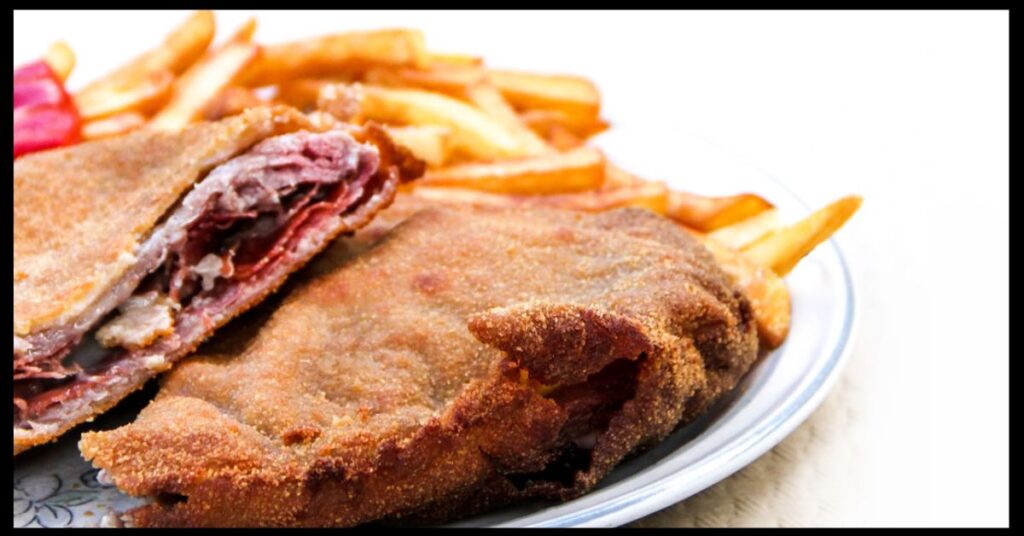Cachopo is a beloved dish from the northern Spanish region of Asturias, known for its hearty and satisfying flavors. Often compared to dishes like schnitzel or cordon bleu, cachopo features breaded and fried veal fillets stuffed with ham and cheese. This traditional meal has gained popularity across Spain and internationally due to its rich taste and straightforward preparation.
Table of Contents
ToggleWhat Is Cachopo?
Cachopo is a classic dish originating from Asturias, Spain. It typically consists of two large veal fillets filled with cured ham and cheese, coated in breadcrumbs, and then fried until golden brown. Served hot, often with French fries or sautéed vegetables, cachopo is a dish that reflects the robust and rustic nature of Asturian cuisine.
While the traditional version uses veal, modern adaptations include variations with chicken, pork, or even fish. Despite regional twists, the hallmark of a good cachopo is a crisp exterior, melty interior, and generous portion size.
Ingredients for Traditional Cachopo
To prepare a traditional cachopo, high-quality ingredients are essential. Here is a list of commonly used items:
Meat and Filling
- 2 large veal fillets (thinly sliced)
- 2–4 slices of Serrano ham or jamón ibérico
- 2 slices of semi-cured cheese (such as Manchego)
Breading and Frying
- 2 eggs (beaten)
- All-purpose flour
- Breadcrumbs
- Olive oil (for frying)
- Salt and pepper to taste
Optional Accompaniments
- French fries
- Roasted peppers
- Mixed green salad
- Aioli or tomato-based sauces

How to Make Cachopo: Step-by-Step Instructions
1. Prepare the Veal Fillets
Lay out the veal fillets on a clean surface. If they are too thick, use a meat mallet to flatten them to about ½-inch thickness. Season both sides with a light sprinkle of salt and pepper.
2. Add the Filling
Place one slice of ham and one slice of cheese on top of a veal fillet. Be sure the filling does not extend beyond the meat’s edges to prevent it from leaking out during frying. Cover with the second veal fillet, creating a “sandwich.”
3. Bread the Cachopo
Dredge the assembled cachopo in flour, ensuring it’s evenly coated. Dip it into the beaten eggs, then coat thoroughly with breadcrumbs. For an extra-crispy texture, some cooks double-dip in egg and breadcrumbs.
4. Fry the Cachopo
Heat a generous amount of olive oil in a large skillet over medium heat. Carefully place the cachopo in the pan and cook for 4–5 minutes per side, or until golden brown and crispy. Use tongs to turn the fillet without breaking the crust.
5. Drain and Serve
Remove the cachopo and place it on a paper towel-lined plate to drain excess oil. Slice and serve immediately with your preferred side dishes.
Popular Variations of Cachopo
While the traditional recipe is a staple, there are many regional and modern interpretations of cachopo:
Chicken Cachopo
A lighter version that uses chicken breast instead of veal. This variation is popular among home cooks and those seeking a leaner option.
Pork Cachopo
Made with pork loin, this type is heartier and often paired with stronger cheeses or spicy fillings like chorizo.
Fish Cachopo
A seafood version typically found along the Asturian coast, using hake or monkfish and filled with shellfish and cheese.
Vegetarian Cachopo
Some modern interpretations use eggplant or portobello mushrooms in place of meat, catering to vegetarian diets while preserving the original dish’s layered and breaded structure.
Nutritional Information
Cachopo is considered an indulgent dish due to its fried preparation and rich ingredients. A standard serving of traditional veal cachopo (approximately 400–500g) contains:
- Calories: 700–900 kcal
- Protein: 45–55g
- Fat: 40–50g
- Carbohydrates: 30–40g
Source: Spanish Food Composition Database (BEDCA)
For a healthier version, baking the cachopo or using an air fryer can significantly reduce the fat content.

Tips for Perfect Cachopo
- Use Thin Fillets: Flattening the veal ensures even cooking and easier handling.
- Seal the Edges: Lightly pressing the edges of the fillets can help prevent the cheese from oozing out during frying.
- Use Quality Cheese: Manchego, Idiazabal, or semi-cured local cheeses provide a rich and authentic flavor.
- Rest Before Serving: Let the fried cachopo rest for a few minutes to retain crispiness and avoid burns from hot cheese.
Serving Suggestions
Cachopo is typically served with rustic accompaniments that complement its richness. Popular sides include:
- French Fries or Patatas Bravas: Crispy and golden, these are a natural fit.
- Pimientos de Padrón (Fried Green Peppers): Their mild heat and soft texture contrast nicely with the crunch of the cachopo.
- Fresh Salad: A mixed greens salad with vinaigrette balances the heaviness of the dish.
- Red Wine or Cider: A glass of Asturian cider or Spanish red wine pairs excellently with cachopo.
Cultural Significance in Asturias
Cachopo is more than just a meal; it’s a source of regional pride in Asturias. It is often featured in local festivals and culinary contests, with chefs competing for the title of “Best Cachopo.” Many Asturian restaurants highlight the dish as a specialty, and it has become a symbol of local cuisine.
According to a 2022 report by the Spanish Gastronomic Association, cachopo ranked among the top ten most-ordered traditional Spanish dishes in the northern regions of Spain.
Conclusion
Cachopo is a quintessential Asturian recipe that combines simple ingredients to create a flavorful, filling, and comforting dish. Whether prepared traditionally with veal or customized with chicken or vegetarian alternatives, cachopo offers versatility and satisfaction for any palate. By following the recipe and tips provided, anyone can recreate this Spanish favorite at home, bringing a touch of Asturias to their kitchen.







